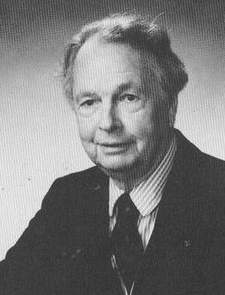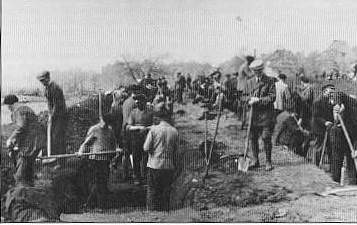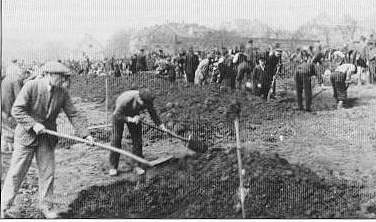
Haynes Dugan arthur of "Spearhead In The West" relates about Nordhausen
From Haynes Dugan's "Spearhead In The West"
Driving for Nordhausen, Task Force Welborn rolled into a vicious battle for the town of Espchenrode. As the column approached the large valley in which the action took place, a number of enemy infantrymen were noted, but bypassed. However, upon entering the town, heavy small arms fire and bazooka attacks began to halt leading elements. A deadly house to house action developed, with Company "F" of the 36th Armored Infantry Regiment leading the initial attack. The day was clear and quite warm. Visibility was unlimited, and General Boudinot directed the action from a point on the road approximately 1000 yards from Espchenrode. Down on the floor of the valley an enemy column made frantic efforts to disperse, take cover, or get beyond the range of Division Artillery, which was now hammering it unmercifully. Piper Club artillery observation planes hovered over the combat area and presently the ground-support Thunderbolts began to slant down to strafe and bomb.
In the town, which was now under attack by tanks and infantry, a fierce fire fight raged for approximately three hours. Many of the enemy defenders could not be routed from buildings even though their retreats were riddled with high explosive and armor piercing tank rounds. There was an intense volume of small arms and bazooka fire.
The entire enemy force in the town of Espchenrode was killed, wounded, or captured. It consisted of six companies of first class troops led by SS officers and supported by a few tanks and artillery pieces. Task Force Welborn mopped up and moved on again at dusk.
Although the taking of Nordhausen did not constitute the heaviest fighting of April 11, that city will live forever in the memories of 3rd Armored Division soldiers as a place of horror. The Americans couldn't believe their eyes. It is all very well to read of a Maidenek, but no written word can properly convey the atmosphere of such a charnel house, the unbearable stench of decomposing bodies, the sight of live human beings, starved to pallid skeletons, lying cheek by jowl with the ten-day dead.
Two task forces of Brigadier General Truman E. Boudinot's Combat Command "B" drove into Nordhausen practically together. They were the assault elements of Colonel John C. Welborn and Lt. Colonel William B. Lovelady. General Boudinot himself was among the first to enter the compound of Nordhausen's slave extermination camp, the former Caserne Boelcke. What he saw will go down in history as one of the greatest outrages against humanity in the entire war of German disregard for the rights and dignities of man. Camp Nordhausen had been bombed by allied airplanes, buit it was not bomb damage which so sickened the general and his troops as they viewed the remains of the Nazi institution. Hundreds of corpses lay sprawled over the acres of the big compound. More hundreds filled the great barracks. They lay in contorted heaps, half stripped, mouths gaping in the dirt and straw: or, they were piled naked, like cordwood, in the corners and under the stairways.
Everywhere among the dead were the living emaciated, ragged shapes whose fever-bright eyes waited passively for the release of death. Over all the area clung the terrible odor of decomposition and, like a dirge of forlorn hope, the combined cries of these unfortunates rose and fell in weak undulations. It was a fabric of moans and whimpers, of delirium and outright madness. Here and there a single shape tottered about, walking slowly, like a man dreaming.
There was no hope for many of the prisoners in this place. Major Martin L. Sherman, a medical officer, estimated that although the army's medical facilities would be immediately put to use there was little chance of more than half the patients surviving. They were so far gone in the depths of starvation that death was a matter of hours. A number of those who had not starved had been shot by SS troopers when they attempted to run for cover during the air bombardment. They were, in a way, lucky.
The highly efficient German herrenvolk who caused the situation at Nordhausen and Dora, that was a place several kilometers to the north, were acting out a clearly defined program. These prisoners were political enemies of the Third Reich, German as well as other European nationals. They were men like Peter Hahn, a German communist, who had been a constant inmate of his country's concentration camps for eight years; like Pole Leitner, a Hungarian electrician, who was dying from the ravages of tuberculosis. They were fourteen year old boys and aged men. They were members of the French Intelligence, Belgians, Poles, Russians -a very babel of tongues and nations, all dying together in the filth and dirt of their own dysentry.
Guarded by SS troops who delighted in beating the prisoners, these men had slept in three-decker wooden bunks, three men in each tier. Now every other man was a sunken corpse and, often as not, his neighbor in the same bed still lived and had the strength to move his eyes, slowly and wonderingly. This was according to plan. The prisoners had worked-had dragged themselves to labor on V-t and V-2 assembly lines although they were starving on a diet of four ounces of black bread and a small amount of thin soup each day. They worked because the SS had a cure for slackers or alleged saboteurs. At Dora they hanged 32 men one day and forced the entire garrison to watch. The prisoners then hauled their comrades to German cremation ovens. The ovens were a very important fixture at Dora. The bodies came in by truckloads, stripped of all clothing, and were dumped on the ground. When crematoriums were full a pyre was constructed outside: first a tier of bodies, then a layer of dry wood: more bodies, and kerosene. They burned well enough for the SS and it didn't matter to them if a few bones were left. In fact, the SS wasn't at all partial: when one of their own men died, he too was shovelled into the oven.
The camp at Dora was elaborate. While Nordhausen was merely a barracks area from which the men were marched to work each morning at 4 A. M., Dora was a factory in itself. There were two parallel tunnels driven into the side of a hill there for a distance of almost two miles. Numbers of crossing tunnels and two separate levels were packed solidly with precision machinery. Here, the slave labor turned out quantities of V-i and V-2 weapons, many of which were intact when CC "B" elements arrived to halt production. Robot bombs were an old story to "Spearhead" troops, but the more unfamiliar V-2 was of interest. They found the weapon to be shaped like a huge cigar with fins, so feet long. It had a huge, mushroom shaped engine and an electrician's nightmare of wiring. V-3, according to prisoners, was also undergoing experiments at Dora, but few of the political prisoners were assigned to its development. Those who were put on V-3 manufacture, according to eye-witness accounts, were segregated and finally murdered to preserve the secret of that which they had seen.
The arrival of American troops was miraculous to the half-crazed and starved slave laborers. At Dora, hysterically happy men attempted to lift Lt. Herbert Gontard to their shoulders.
Although the Lt. was a slim man the weakened labors couldn't lift him.
Nordhausen and Dora were efficient in a characteristic Nazi way, but to the shocked eyes of American fighting men, the camps were the most complete condemnation of Hitlerism yet exposed. The men of the 3rd were in a savage mood as they went on to the final battles.


Local Germans citizens were made to dig the mass graves for thousands of Jewish Prisoners 13 April 1945
(Courtesy of Mrs. E.D. Sylvester)
Back to Nordhausen



